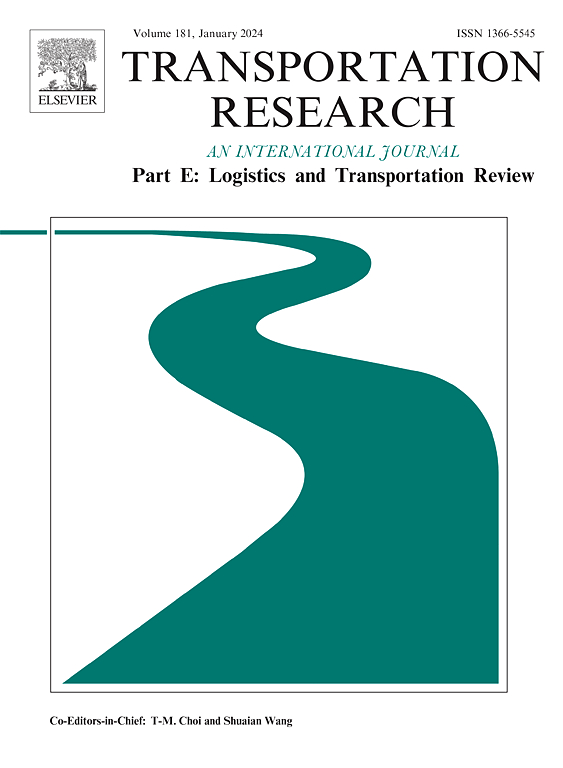Data-driven predictive model for dynamic expected travel time estimation in rail freight networks: A case study
IF 8.8
1区 工程技术
Q1 ECONOMICS
Transportation Research Part E-Logistics and Transportation Review
Pub Date : 2025-05-29
DOI:10.1016/j.tre.2025.104201
引用次数: 0
Abstract
Rail freight is vital for economic growth due to its efficiency and environmental benefits, but its lack of fixed schedules due to various delay factors poses challenges for accurate Expected Travel Time (ETT) predictions. This research addresses the need for real-time, accurate and dynamic ETT predictions crucial for maintaining efficient supply chains by developing a novel predictive model that leverages real-time data. The model ensembles Graph Convolutional Network-Long Short-Term Memory (GCN-LSTM) and Kalman Filters (KF) models to capture the complex spatiotemporal interactions and diverse traction behaviours within the freight train railway network. The methodology comprises three phases: modeling, schedule generation, and dynamic updating. In the modeling phase, historical train movement data is used to develop predictive models, with KF handling state-space representation and GCN-LSTM capturing spatial and temporal dependencies. These models are ensembled to enhance prediction accuracy. The schedule generation phase estimates travel times using the ensembled model, the dynamic updating phase refines predictions using real-time data, while congestion is assessed by clustering congested areas with Density-Based Spatial Clustering of Applications with Noise (DBSCAN) and propagating these clusters through KF. The proposed model is compared with different state-of-art predictive models. The methodology’s effectiveness was validated using real-world data from Indian Railway freight operations. The proposed model demonstrated superior accuracy, with Mean Absolute Percentage Error of 19.51%, while the moving average-based model which was previously being used by the Indian Railway had an error of 44.34%. This approach, implemented as a decision support system for Indian Railways’ daily operations, provides advanced planning solutions to manage the growing complexities of rail freight logistics effectively.
基于数据驱动的铁路货运网络动态预期行程时间预测模型:一个案例研究
铁路货运由于其效率和环境效益对经济增长至关重要,但由于各种延误因素而缺乏固定的时间表,这对准确预测预期旅行时间(ETT)提出了挑战。本研究通过开发一种利用实时数据的新型预测模型,解决了对实时、准确和动态ETT预测的需求,这对于维持高效的供应链至关重要。该模型集成了图卷积网络-长短期记忆(gn - lstm)和卡尔曼滤波(KF)模型,以捕获货运列车网络中复杂的时空相互作用和不同的牵引行为。该方法包括三个阶段:建模、进度生成和动态更新。在建模阶段,历史列车运动数据用于开发预测模型,KF处理状态空间表示,GCN-LSTM捕获空间和时间依赖关系。将这些模型组合起来以提高预测精度。计划生成阶段使用集成模型估计出行时间,动态更新阶段使用实时数据改进预测,而拥堵通过基于密度的空间噪声应用聚类(DBSCAN)对拥堵区域进行聚类并通过KF传播这些聚类来评估。并将该模型与现有的预测模型进行了比较。使用来自印度铁路货运业务的真实数据验证了该方法的有效性。提出的模型显示出更高的准确性,平均绝对百分比误差为19.51%,而印度铁路之前使用的基于移动平均的模型误差为44.34%。这种方法作为印度铁路公司日常运营的决策支持系统,为有效管理日益复杂的铁路货运物流提供了先进的规划解决方案。
本文章由计算机程序翻译,如有差异,请以英文原文为准。
求助全文
约1分钟内获得全文
求助全文
来源期刊
CiteScore
16.20
自引率
16.00%
发文量
285
审稿时长
62 days
期刊介绍:
Transportation Research Part E: Logistics and Transportation Review is a reputable journal that publishes high-quality articles covering a wide range of topics in the field of logistics and transportation research. The journal welcomes submissions on various subjects, including transport economics, transport infrastructure and investment appraisal, evaluation of public policies related to transportation, empirical and analytical studies of logistics management practices and performance, logistics and operations models, and logistics and supply chain management.
Part E aims to provide informative and well-researched articles that contribute to the understanding and advancement of the field. The content of the journal is complementary to other prestigious journals in transportation research, such as Transportation Research Part A: Policy and Practice, Part B: Methodological, Part C: Emerging Technologies, Part D: Transport and Environment, and Part F: Traffic Psychology and Behaviour. Together, these journals form a comprehensive and cohesive reference for current research in transportation science.

 求助内容:
求助内容: 应助结果提醒方式:
应助结果提醒方式:


